Glossary
Type of concrete
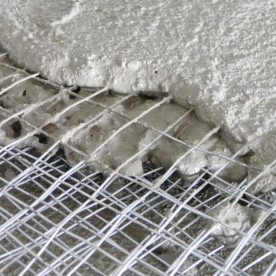
Ferrocement
Ferrocement was developed by P.L.Nervi, an Italian architect, in 1940.
A composite structural material comprising thin sections consisting of cement mortar reinforced by several closely spaced layers of steel wire mesh.
Ferrocement is a low self-weight, highly versatile form of reinforced concrete.
It consists of cement mortar and a large amount of small-diameter wire mesh embedded uniformly throughout the cross section. The strength depends on two factors: the quality of the sand/cement mortar mix and the quantity of reinforcing materials used.
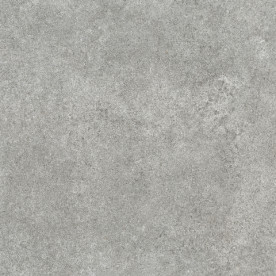
Plain concrete
Mass concrete, for structural use, without rebars or reinforcements to withstand tensile stress.
Therefore, it performs well in compression, but its ability to withstand tensile stresses will be very limited.
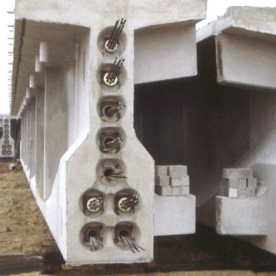
Prestressed concrete
Structural concrete in which internal stresses have been introduced to reduce potential tensile stresses resulting from loads.
Prestressing is a method that helps increase the strength of reinforced concrete, specifically making it possible to increase the distances between supports. As such, it is very common in bridge construction and for creating large spans without intermediate supports.
These long spans are achieved by subjecting the structural elements to compressive forces in an initial resting position, prior to their use in construction. Once the elements are subject to loading, their capacity to withstand axial tensile stresses is increased and their structural behavior is substantially improved.
Prestress — (1) to place a hardened concrete element or an assembly of units in a state of compression before the application of service loads; (2) the stress developed by prestressing, such as by pre-tensioning or post-tensioning.
Pre-tensioning — method of prestressing reinforced concrete in which prestressing steel is tensioned before the concrete is placed.
Post-tensioning — method of prestressing reinforced concrete in which tendons are tensioned after the concrete has attained a specified minimum strength or a specified minimum age.
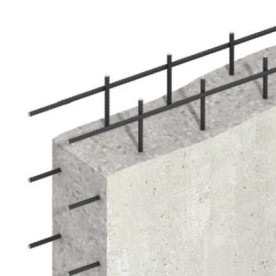
Reinforced concrete
Introduced in the 1850s by the French industrialist François Coignet.
Concrete is a relatively brittle material that is strong in compression but less so in tension.
To increase its overall strength, steel rods, wires, mesh or cables may be embedded in concrete before it sets. This reinforcement, often known as rebar, resists tensile forces. By forming a strong bond, the two materials are able to resist a variety of applied forces, effectively acting as a single structural element .
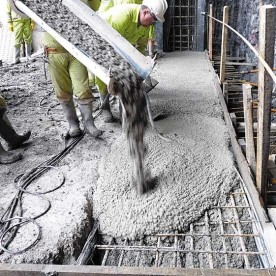
Cast-in-place concrete, in-situ concrete
This is the most common construction method, in which concrete is poured directly into molds or formwork at the construction site, in the final position where it will be needed as part of the structure.
In this case, the concrete can be made by mixing the components directly on site, or it may be transported from a production plant in concrete-mixer trucks.
This method has the disadvantage of leaving the concrete exposed to the elements while it is setting. Whereas, with other methods, the environmental conditions can be controlled during setting, providing greater control over the outcome, with cast-in-place concrete a series of tests and protocols are necessary to verify its final strength.
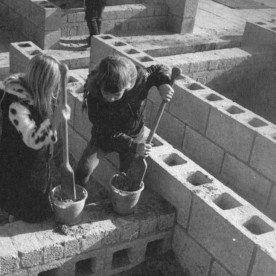
Concrete masonry units, such as concrete blocks
Prefabricated elements, usually in a size that can be manipulated by hand, which are laid like bricks, i.e., following a laying pattern or guide.
Normally, the elements are made for commercialization, to standard measurements. In special cases, however, a specific element may be designed for a particular project, which may also include its own anchoring system.
One of the most well-known cases of the design of a system of specific blocks and supports is Frank Lloyd Wright’s ‘textile block’ .
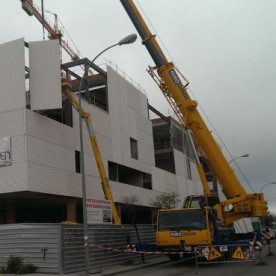
Facade cladding
This is a specific type of prefabricated concrete element, intended for use on building façades .
In its design, the element should account for aspects such as modulation, finishes, transportation, anchoring, installation on site, junctions between panels, the creation of openings and the relationship between the panels and joinery. The element may also be given characteristics that can improve the thermal insulation of the façade, for example. In that sense, they are often part of an industrialized system that offers a variety of responses to different construction situations and maximum versatility in terms of architectural solutions.
The aesthetic possibilities of concrete in prefabricated façade panel systems are endless in terms of size, shape, color, texture, hardness and a wide range of features.
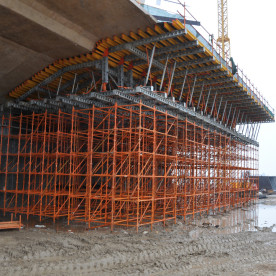
Formwork, falsework, centering
Formwork refers to the temporary or permanent molds into which concrete or a similar material is poured. In the context of concrete construction, the falsework supports the shuttering molds.
Traditionally, formwork is built on site using timber and plywood or moisture-resistant particleboard. It is easy to produce but time-consuming for larger structures, and the plywood facing has a relatively short lifespan. It is still used extensively in cases where the labor costs are lower than the costs of procuring reusable formwork. Traditional formwork is also the most flexible type, so it may be used for complicated sections even when other systems are also being employed.
In contrast, modular systems made from re-usable plastic formwork are used to build widely variable, but relatively simple, concrete structures.
Falsework and centering are temporary frames used to support formwork; centering is often used specifically for the construction of an arch or vault
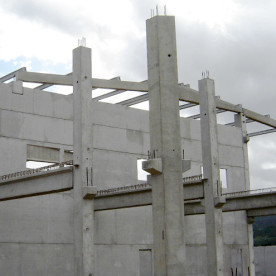
Precast concrete, precast element
Concrete that is cast somewhere other than its final position. An element manufactured at a casting plant or on site but not in its final position.
PRECAST ON SITE:
In larger and more complex construction projects, a concrete production plant may be installed on the construction site or nearby. The precast elements are moved into place once they have reached their maximum strength. This reduces transportation costs and ensures the concrete will set in the same environmental conditions as the building site. This may be more necessary with structures that combine cast-in-place concrete with prefabricated elements.
PRECAST IN FACTORY, WORKSHOP:
Any concrete element can be manufactured ahead of time and transported to the site once it has set. In this case, the control over geometry, appearance, finish and strength can be as strict as necessary. It can also be ensured that the pieces will be exactly identical to one another.
Prefabricated elements can be of any type: from façade panels and pavements to decorative elements (such as cornices or capitals) and structural elements (columns, slabs, beams, etc.).
These elements may be part of a commercial catalog or specially designed for a specific project. A series of pieces may also be sold as a coordinated and interconnected system to build a complete structure or even an entire building.
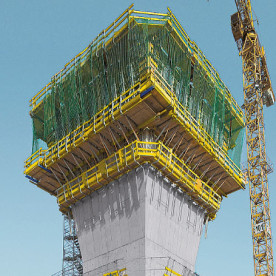
Sliding/climbing formwork
It is a special type formwork for vertical concrete structures that rises with the building process. While relatively complicated and costly, it can be an effective solution for buildings that are either very repetitive in form (such as towers or skyscrapers) or that require a seamless wall structure.
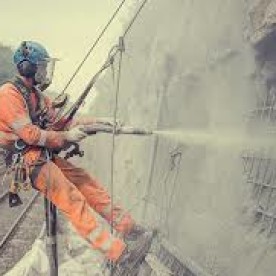
Sprayed concrete, shotcrete
Sprayed concrete is sprayed into place, rather than using the more common method of pouring or placing concrete into formwork. This method is used most often in the consolidation of tunnels, plots of land, etc...
Dry-process sprayed concrete: a predetermined dry mix of cement and aggregate is propelled through a spraying nozzle, while a finely atomized spray of water is added to the stream of materials to hydrate the cement.
Wet-process sprayed concrete: batched wet concrete is pumped through a hose or pipe to a discharge nozzle, where high-pressure air propels the concrete into position.
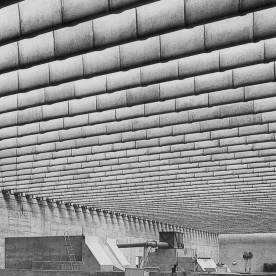
Voussoirs and Assemblies
A specific type of prefabricated concrete piece that can be combined to form larger structural elements.
Voussoirs are the pieces that join together to form an arch. In the context of reinforced concrete structures, this idea also holds true for linear structures (beams, girders) that are built by adding small pieces that fit together, like vertebrae in a spinal column. The pieces used in these structures are prefabricated, and they are specifically designed to form a system.
The Spanish architect Miguel Fisac can be considered a master of this type of structure
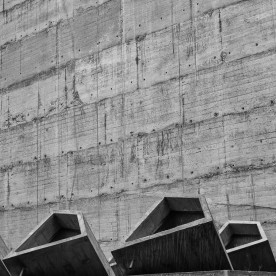
Architectural concrete
Concrete that will be permanently exposed to view and therefore requires special care in the selection of the materials, forming, placing and finishing to obtain the desired architectural appearance, examples include :
- textured walls
- wooden formwork finish
- stamped concrete
- exposed aggregate concrete, colored concrete, etc.
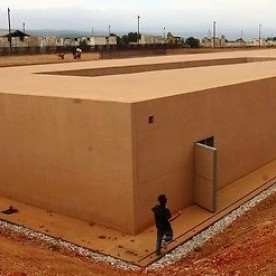
Colored concrete
Integrally colored concrete is made by adding mineral oxide pigments to concretes made with either white or grey cements. White cement is used for lighter shades of concrete, but red, tan and dark grey hues can be made using grey cement .
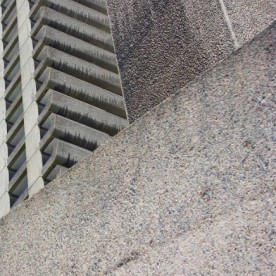
Exposed aggregate concrete
The aggregates and additives used in concrete can be chosen to give the desired surface finish through combinations of materials, textures, shapes and sizes, colors, etc...
To achieve a more noticeable effect, surface treatments can be applied to the concrete after it has set to expose the aggregates and create texture, shine or roughness.
Some examples include terrazzo pavements and many types of prefabricated façade panels.
There are various exposure methods contractors can choose from, depending on the desired look and the size of the project:
- brushing and washing
- using a surface retarder
- abrasive blasting
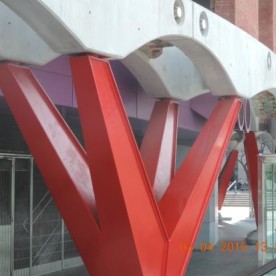
Hybrid structures
A hybrid structure combines different resistant materials, forming a structural unit. The most common materials used in this type of structure are: steel, wood and concrete. In these structures, there need to be elements of connection and conjunction between the different materials. These elements may be highly complex, since they connect materials with different behaviors and deformations in response to loads.
![One-dimensional/ [mushroom] column](https://100of20.innovaconcrete.eu/storage/innova-concrete/characteristics/19/iq4wlimkHCyUVuzVOHDUUvyZsp8WZDZeSfjgZjO2.jpeg)
One-dimensional/ [mushroom] column
In reinforced concrete construction, a structural column with a shape that recalls a mushroom, flaring at the top to counteract sheering stresses.
This element is characteristic of many industrial buildings from 1900 to 1950 in which large, flared support structures extend into disc-like capitals.
![One-dimensional/ [trussed] beam](https://100of20.innovaconcrete.eu/storage/innova-concrete/characteristics/18/EMsiB9TWPL49SwD4RANZHmFQhpYodLqBIrmtQRJG.jpeg)
One-dimensional/ [trussed] beam
Beams are linear support elements, which are placed horizontally between vertical supports. They are designed and calculated to resist and transmit transverse loads to the elements supporting them.
Trussed beams are the cheapest solution for the execution of large spans, in other words, when there are large distances between vertical supports. In reality, this type of beam is a kind of lattice, made up of a series of shorter braces (posts and struts).
Trussed beams are usually made of steel or wood, since some of the elements of the structure will be subject to compression and others to traction. As such, it is unusual for structures of this type to be built only with concrete. Using a combination of concrete for compression and steel to absorb traction results in better structural performance.
![One-dimensional/arch [bridge]](https://100of20.innovaconcrete.eu/storage/innova-concrete/characteristics/20/sPdOsScqPlWwnyGuV25XX2lwultxiLWCQ4VWfVge.jpeg)
One-dimensional/arch [bridge]
An arch bridge is a bridge with abutments at each end and that is shaped like a curved arch. Arch bridges work by transferring the weight of the bridge and its loads partially into a horizontal thrust, restrained by the abutments on either side. A viaduct (a long bridge) may be made of a series of arches, although alternative, less expensive structures are typically used today.
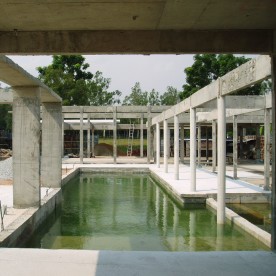
One-dimensional/concrete frame
A concrete frame is a common form of structure, comprising a network of columns and connecting beams, which forms the structural “skeleton” of a building. This grid of beams and columns is typically built on a concrete foundation and is used to support the building’s floors, roof, walls, cladding and so on.
Beams are the horizontal load-bearing elements of the frame. Columns are the vertical elements of the frame and act as the building’s primary load-bearing element. They transmit the beam loads down to the foundations.
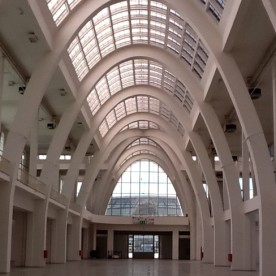
One-dimensional/diaphragmatic arches
The diaphragm arch is one of the oldest and simplest structural forms in existence. Diaphragm arches were widely used, for example, in Gothic civil architecture.
A series of arches are situated parallel to one another at a distance that allows for covering them with smaller secondary structures such as beams or plates. This type of structure also calls for support elements perpendicular to the arches to avoid the “domino” effect .
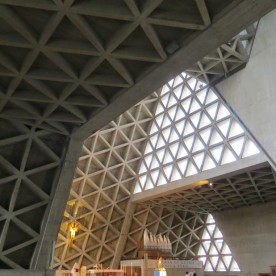
Three-dimensional space structure
Although this structural typology is usually associated with steel structures, three-dimensional meshes have also occasionally been built using reinforced concrete in the case of large structures, sometimes associated with major infrastructures like bridges.
One might argue that the behavior of any concrete structure using columns and beams is consistent with that of a three-dimensional mesh. In this case, however, we are referring mainly to unique structures, in which the expressiveness of the structure is also highlighted in the finishes.
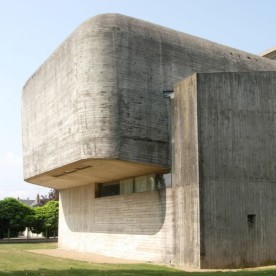
Three-dimensional/mass concrete, solid masses
Concrete without reinforcement that absorbs thermal stresses and retraction. Generally speaking, these tend to be large-volume structures subject mainly to compression (since the absence of rebars means that they perform poorly in the presence of traction forces) .
Mass concrete structures include large slabs and foundation elements, dams, and other concrete structures in which the minimum dimension is larger than three meters.
![Two-dimensional/ [shear] wall](https://100of20.innovaconcrete.eu/storage/innova-concrete/characteristics/22/xY970Hb84sNFNXz0zXp2WIFrHQt64nXffTHQjvcF.jpeg)
Two-dimensional/ [shear] wall
A shear wall is a vertical element in a seismic force resisting system, which is designed to resist in-plane lateral forces: typically wind and seismic loads.
A shear wall resists loads parallel to the plane of the wall. Collectors, also known as drag members, transfer the diaphragm shear to shear walls and other vertical elements in the seismic force resisting system. Shear walls are typically light-framed or braced wooden walls with shear panels, reinforced concrete walls, reinforced masonry walls or steel plates.
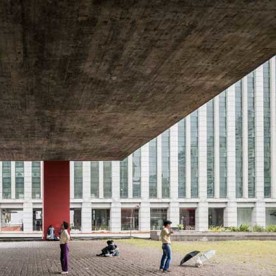
Two-dimensional/Slab
A concrete slab is a common structural element of modern buildings, consisting of a flat, horizontal surface made of cast concrete.
![Two-dimensional/[cantilever] roof, [suspended] roof](https://100of20.innovaconcrete.eu/storage/innova-concrete/characteristics/26/2VqwzGySeiSZ8j4tDwsPKq6tN0Ep6xWpUDKg56RL.jpeg)
Two-dimensional/[cantilever] roof, [suspended] roof
A cantilever is a rigid structural element, a beam for example, that is anchored one side to a support (usually vertical), from which it protrudes. Cantilevers can also be built with trusses or slabs. A cantilever subjected to a load transmits that load to the support to which it is attached, generating a moment and a shear stress.
The construction of cantilevers creates structures that protrude from their supports without external reinforcements, contrasted with constructions supported at both ends, where the load is distributed between them, like in the case of a beam or a lintel. Formal strategies can be used to improve the structural performance of the cantilever and reduce thicknesses.
A suspended roof refers to the case where the vertical supports do not rest on the ground but hang from a structure above. Steel cables are often used for these supports, since they are only subject to traction forces.
![Two-dimensional/[cylindrical two-dimensional/barrel] vault](https://100of20.innovaconcrete.eu/storage/innova-concrete/characteristics/25/k1E59VEXlzivs3L6VjwNzP9iE8rq9eQ5scRXjsos.jpeg)
Two-dimensional/[cylindrical two-dimensional/barrel] vault
A barrel vault, also known as a tunnel vault or a wagon vault, is an architectural element formed by the extrusion of a single curve (or a pair of curves, in the case of a pointed barrel vault) along a given distance. The curves are typically circular in shape, lending a semi-cylindrical appearance to the design as a whole. The barrel vault is the simplest vault form: effectively, it is a series of arches placed side by side.
It is an archetypal form and one of the oldest forms in architecture, dating all the way back to prehistoric times. It is characterized by being subject only to compression loads, although it produces outward thrusts that need to be absorbed either through volume or geometric strategies (such as buttresses or flying buttresses). It is a typical structure used in tunnels.
![Two-dimensional/[doubled spherical] dome](https://100of20.innovaconcrete.eu/storage/innova-concrete/characteristics/23/htrj7LdaBQ8urjrgA5yEyyJ4m93JloMGtpFVdxFx.jpeg)
Two-dimensional/[doubled spherical] dome
A type of shell with allied double curvature. A dome is an architectural element that resembles the hollow upper half of a sphere .
Domes have a long architectural lineage that extends back into prehistory, and they have been built from mud, snow, stone, wood, brick, concrete, metal, glass and plastic over the centuries.
![Two-dimensional/[inverted] cupola, [pyramidal] cupola](https://100of20.innovaconcrete.eu/storage/innova-concrete/characteristics/24/THVZDeLHn6QvjKxh9TuJarpvB0rvwneEnzEgbXdH.jpeg)
Two-dimensional/[inverted] cupola, [pyramidal] cupola
A two-dimensional structure in the shape of a dome, the surface of which is formed by flat sides or faces. It may sometimes be a regular structure made up of polygons, such as the dodecahedron. Geometrically, the faces that form the dome are usually triangles or regular polygons.
![Two-dimensional/[waffle] slab](https://100of20.innovaconcrete.eu/storage/innova-concrete/characteristics/27/tBOrjpNxtskNbnoFnRmqfpPShI64rYYeQdIXj64t.jpeg)
Two-dimensional/[waffle] slab
A waffle slab or two-way joist slab is a concrete slab made of reinforced concrete that is characterized by ribs in two directions giving it the appearance of a waffle or a grid. (source: Harris, Dictionary of Architecture and Construction). A waffle slab is flat on top, whereas joists create a grid-like surface on the bottom. The grid is formed using molds, which are removed after the concrete sets.
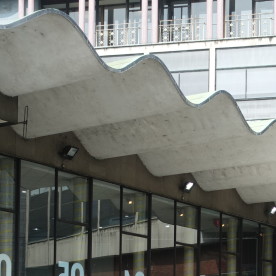
Two-dimensional/folded plate structure
This method of construction takes advantage of the strength of reinforced concrete, while also taking into account the shape of the elements in order to increase the structural resistance.
In this case, the strategy involves folding a hypothetical flat surface (a plate or membrane) to increase its inertia. This allows for saving material and achieving increasingly lightweight structures.
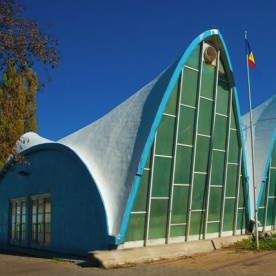
Two-dimensional/shell structure
A thin three-dimensional structure, in which, as in the previous case, the shape of the element provides its structural resistance. Beginning from a membrane structure or “shell”, in this case the surface is curved (simple or double curvature) in order to increase its strength.
The shape of the structure as a whole usually coincides with that of the building, as in the case of vaults or domes, for example.
Felix Candela and Pier Luigi Nervi both made exemplary use of this type of structure.
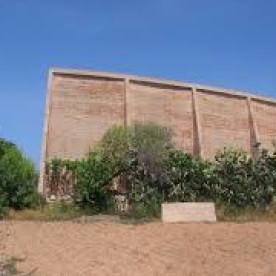
Vertical wall structure
One dimensional or two-dimensional wall. It can be implemented with stiffeners to counteract horizontal forces


